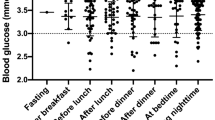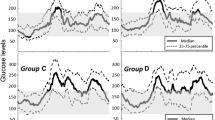Abstract
A study was conducted to evaluate the accuracy of GlucoDay (A. Menarini Diagnostics) during 48 h of continuous glucose monitoring (CGMS) in type 1 diabetic adolescents and use this novel approach to assess otherwise ignored nocturnal hypoglycaemias, in relationship to intermediate-acting insulin administration timing. Twenty type 1 diabetic adolescents with poor metabolic control were selected from our out-patient department. Equal doses of intermediate insulin were administered at 19:00 and at 22:00 of the first and second night of the study, respectively. Correlation coefficient between GlucoDay and standard glucometer was 0.94; 98.3% of data fall in the A + B area of Error Grid Analysis and 1.7% in the D area. The mean error was 13.9% overall and 16.4% with blood glucose values (BGV) <75 mg/dl. The accuracy, ±15 mg/dl, was 82% for BGV <75 mg/dl and 74% for BGV >75 mg/dl. The CGMS discovered nocturnal hypoglycaemia (NH) in 12/18 patients, but no severe hypoglycaemia. During the first night, 8 asymptomatic NH episodes were found with BGV <60 mg/dl and 12 with BGV <80. During the second night, 4 asymptomatic NH episodes with BGV <60 mg/dl and 5 with BGV <80 were found. Furthermore, during the second night, the mean duration of BGV <126 mg/dl was lower than in the first night. GlucoDay is a reliable device for CGMS in paediatric patients and able to determine asymptomatic NH. Bedtime insulin injections provided safer glycaemic profiles and a lower percentage of hypoglycaemic events, representing a safer insulin administration scheme.



Similar content being viewed by others
References
The Diabetes Control Complications Trial (DCCT) Research Group (1993) The effect of intensive treatment of diabetes on the development and progression of long term complication in insulin-dependent diabetes mellitus. N Engl J Med 329:977–986
Writing Team for the Diabetes Control, Complication Trial/Epidemiology of Diabetes Interventions, Complication Research Group (2003) Sustained effect of intensive treatment of type 1 diabetes mellitus on development and progression of diabetic nephropathy: the Epidemiology of diabetes interventions and complictions (EDIC) study. JAMA 290(16):2159–2167
Mortensen HB, Hougaard P (1997) Comparison of metabolic control in a cross-sectional study of 2, 873 children and adolescents with IDDM from 18 countries. The Hvidore Study Group on Childhood Diabetes. Diabetes Care 20(5):714–720
The Diabetes Control Complications Trial (DCCT) Research Group (1997) Hypoglycaemia in the DCCT. Diabetes 46:271–286
Bergada I, Suissa S, Dufresne J, Schiffrin A (1989) Severe hypoglycaemia in IDDM children. Diabetes Care 12:239–244
Giménez M, Lara M, Jiméne A, Conget I (2009) Glycaemic profile characteristics and frequency of impaired awareness of hypoglycaemia in subjects with T1D and repeated hypoglycaemic events. Acta Diabetol 46(4):291–293
Goksen D, Darcan S, Buyukinan M, Köse T, Erermis S, Coker M (2008) The effect of insulin glargine and nutritional model on metabolic control, quality of life and behavior in children and adolescents with type 1 diabetes mellitus. Acta Diabetol 45(1):47–52
Matyka KA, Wigg L, Pramming S, Stores G, Dunger DB (1999) Cognitive function and mood after profound nocturnal hypoglycaemia in prepubertal children with conventional insulin treatment for diabetes. Arch Dis Child 81(2):138–142
Ryan C, Vega A, Drash A (1985) Cognitive deficits in adolescents who developed diabetes early in life. Pediatrics 75(5):921–927
Chase HP, Kim LM, Owe SL et al (2001) Continuous subcutaneous glucose monitoring in children with type 1 diabetes. Paediatrics 107(2):222–226
Salardi S, Zucchini S, Santoni R, Ragni L (2002) The glucose area under the profiles obtained with continuous glucose monitoring system relationships with HbA1c in paediatrics type 1 diabetic patients. Diabetes Care 25:1840–1844
Schiaffini R, Ciamaplini P, Fierabracci A, Spera S, Borrelli P, Bottazzo P, Crinò A (2002) The continuous glucose monitoring system (CGMS) in type 1 diabetic children is the way to reduce hypoglycaemic risk. Diabetes Metab Res Rev 18:324–329
Fiallo-Scharer R, Diabetes Research in Children Network Study Group (2005) Eighth-point glucose testing versus the continuous glucose monitoring system in evaluation of glycemic control in type 1 diabetes. J Clin Endocrinol Metab 90(6):3387–3391
Maran A, Crepaldi C, Tiengo A, Grassi G, Vitali E, Pagano G, Bistoni S, Calabrese G, Santeusanio F, Leonetti F, Ribaudo M, Di Mario U, Annuzzi G, Genovese S, Riccardi G, Previti M, Cucinotta D, Giorgino F, Bellomo A, Giorgino R, Poscia A, Varalli M (2002) Continuous subcutaneous glucose monitoring in diabetic patients. Diabetes Care 25:347–352
Ludvigsson J, Hanas R (2003) Continuous subcutaneous glucose monitoring improved metabolic control in paediatric patient with type 1 diabetes: a controlled crossover study. Paediatrics 111:933–938
Bolli GB (1999) How to meliorate the problem of hypoglycaemia in intensive as well as nonintensive treatment of type 1 diabetes. Diabetes Care 22(suppl 2):B43–B52
Fanelli CG, Campanelli S, Porcellani F, Rossetti P, Brunetti P, Bolli G (2002) Administration of neutral protamine Hagedorn insulin at bedtime versus with dinner in type 1 diabetes mellitus to avoid nocturnal hypoglycaemia and improve control. Ann Intern Med 136:504–514
Diabetes Research in Children Network (DirecNet) Study Group (2004) Accuracy of the GlucoWatch G2 biographer and the continuous glucose monitoring system during hypoglycemia: experience of the Diabetes research in Children Network. Diabetes Care 27:722–726
Mohn A, Strang S, Wernicke-Panten K, Lang AM, Edge JA, Dunger DB (2000) Nocturnal Glucose control and free insulin levels in children with type 1 diabetes by use of the long-acting insulin HOE 901 as part of a three-injection regimen. Diabetes Care 23:557–559
Chase HP, Dixon B, Pearson J, Fiallo-Scharer R, Walravens P, Klingensmith G, Rewers M, Garg SK (2003) Reduced hypoglycemic episodes, improved glycaemic control in children with type 1 diabetes using insulin glargine, neutral protamine Hagerdorn insulin. J Pediatr 143(6):704–706
Weitrob N, Schechter A, Benzaquen H, Shalitin S, Lilos P, Galatzer A, Phillip M (2004) Glycaemic patterns detected by continuous glucose sensing in children, adolescent with type 1 diabetes mellitus treated by multiple daily injection vs continuous subcutaneous insulin infusion. Arch Pediatr Adolesc Med 158(7):677–684
Mauras N, Beck RW, Ruedy Kj, Kollman C, Tamborlane WN, Chase HP, Buckingham BA, Tsalikian E, Weinzimer S, Booyh AD, Xing D, Diabetets Research in Children Network (direcNet) accuracy study (2004) Lack of accuracy of continuous glucose sensors in healthy, nondiabetic children: results of the Diabetes Research in Children Network (Direcnet) accuracy study. J Pediatr 144(6):770–775
Kovatchev B, Anderson S, Heinemann L, Clarke W (2008) Comparison of the numerical and clinical accuracy of four continuous glucose monitors. Diabetes Care 6:1160–1164
DeVreis JH, Wentholt IME, Masurel N, Mantel I, Poscia A, Maran A, Heine RJ (2004) Nocturnal hypoglycaemia in type 1 diabetes–consequences and assessment. Diabetes Metab Res Rev 20(suppl 2):S43–S46
Wenthold IM, Vollebregt MA, Haart AA, Hoekstra JB, DeVries JH (2005) Comparison of a needle-type and microdialysis continuous glucose monitor in type 1 diabetic patients. Diabetes Care 28:2871–2876
Kubiak T, Wole B, Kuhr B, Nied I, Glasner G, Hermanns N, Kulzer B, Haak T (2006) Microdialysis–based 48 hours continuous glucose monitoring with glucoday: clinical performance and patient’s acceptance. Diabtetes Techol Ther 8:570–575
Acknowledgments
This study was funded by a research grant from Menarini I.F.R., Florence, Italy. We thank Alessandro Poscia, Silvia Beghin, and Alberto Maran for their expert assistance.
Author information
Authors and Affiliations
Corresponding author
Rights and permissions
About this article
Cite this article
Meschi, F., Bonfanti, R., Rigamonti, A. et al. Patients’ evaluation of nocturnal hypoglycaemia with GlucoDay continuous glucose monitoring in paediatric patients. Acta Diabetol 47, 295–300 (2010). https://doi.org/10.1007/s00592-010-0181-9
Received:
Accepted:
Published:
Issue Date:
DOI: https://doi.org/10.1007/s00592-010-0181-9




